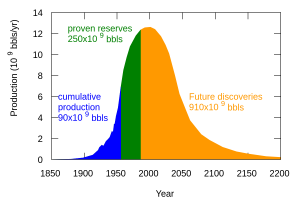
Many critics and experts have an opinion regarding whether Peak Oil is impending, the term for the event when oil energy consumption exceeds the amount extracted from the earth’s natural reserves. But not even the International Energy Agency (IEA), the world’s central agency that handles petroleum supply intelligence knows when, or even if, Peak Oil will occur.
The latest predictions show a higher demand and potential shortages, but the U.S. may help bridge the gap with an increased supply, which may offset the increased tapping of reserves.
Possible Oil Shortage
In the long-term, BP claims that the world would need about 45 percent more energy in 2030 than is consumed today in order to avoid Peak Oil.
While today, there are concerns about a shortage that affect everyday Americans and people globally include an increase in food, heating and transportation costs which would impact the quality of life and survival for many nations, particularly those with marginal living conditions. Virgin Airlines and other UK-based business leaders funded a report that predicts shortages and price spikes in 2015.
While the IEA officially says that currently the short-term status of global oil reserves is safe, according to the U.K. publication The Guardian, many officials disagree internally about the organization’s public stance.
U.S. Supply may be Increasing

Also, in 2015, the IEA predicts that due to recent technology and reserve discoveries,the U.S. will surpass other primary oil producing countries such as Russia and Saudi Arabia, in oil production.
The prediction estimates that the U.S. oil production will increase from 9.2 million barrels per day in 2012, to11.6 million barrels a day in 2020, according to the IEA.
The Variables Involved in Calculating Peak Oil and Petroleum Reserves
It is unclear when or if Peak Oil will occur because the ability for experts to estimate oil supply levels is uncertain due to the continually changing variables used in making predictions.
- The discovery of untapped petroleum reserves is ongoing, such as in North America, where new supplies in Canada, North Dakota and Mexico have increased the known reserve amount significantly.
- The continual invention of new technology methods for extracting oil has increased the production rate. Hydraulic fracturing is a petroleum production method that uses water pressure to remove oil, a process that has increased the supply and the access to remote oil, such as deep water petroleum reserves in the Atlantic Ocean. Another factor is that hydraulic fracturing, while more effective and efficient, is also more expensive in many cases, meaning the gross price of oil production may be increasing. This could, in turn, increase the cost of gas and other oil energy products despite an increase in supply domestically.
- The expanding use of renewable energy sources in high oil consumption countries, such as in the U.S., where wind and solar power are becoming more common through incentives and public awareness of oil conservation, is changing the commercial and residential demand for oil.
- The known amount of global petroleum reserves is likely inaccurate because the Organization of the Petroleum Exporting Countries (OPEC) are not required to supply accurate numbers regarding the amount of oil they have in reserve. There is no organization or checks and balances system that verifies the claims that they make, and they have an incentive to exaggerate the numbers because they receive more funding if the number is higher. Due to the lack of transparency, the world does not know how much known oil is in the global oil reserves inventory.
- There are numerous forms of oil, some of which are easily converted to primary energy fuel used for transportation and product manufacturing and others that require chemical change. Therefore the oil supply amount that is known is often inaccurate due to the inexact nature of the chemical composition inventory.